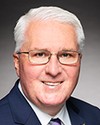Mr. Speaker, I want to begin my remarks today with a point of refutation, because in listening to the debate we have heard some discussion around inequality in Canada, with the member for Saanich—Gulf Islands using the phrase a “crisis in Canada with inequality”. We need to review the record with respect to inequality. Frankly, this bill is going in the wrong direction.
However, over the last 10 years as a government we had a really positive record addressing inequality, as the numbers clearly show. As I have mentioned before, at the beginning of our mandate we lowered the GST, which is the tax that all Canadians pay. We also cut the lowest marginal tax rate. This is a very different approach from that of the current government.
In my view, the best way to measure inequality is through something called “intergenerational earnings elasticity”, which is the ability of people to move between different income brackets across generations. In other words, what are someone's chances of being a wealthier person even if he or she had relatively lower income parents and vice versa?
I will refer members to a paper written by Miles Corak from the University of Ottawa. If we look at the data on intergenerational earnings elasticity, the numbers are clear that Canada is near the top when it comes to equality. In terms of intergenerational earnings elasticity, Canada gets a score of 0.19, where low is good. We are fourth in the world. We are far ahead of the United Kingdom, France, Italy, and countries with a very different social system. We are also ahead of the United States. Therefore, we have a combination of factors in Canada that is good for equality. I would argue that it is a combination of certain necessary social programs in areas like education and health care but also of economic opportunity, and what we have had historically over the last 10 years with limited but effective regulation of business and low business taxes. This environment has been good for equality. It is one thing for members to throw out phrases like “crisis in Canada with inequality”, but if we look at the data specifically I would argue that with respect to intergenerational earnings elasticity, we see that Canada is in a very good spot right now.
Nonetheless, I would argue, and here I agree with our colleagues in the NDP, that this bill does not move in the right direction with respect to inequality because it cuts taxes in certain categories but not in others. Many low- and moderate-income Canadians would not benefit at all.
I am concerned about this bill because we might call this a Liberal promise-wrecking ball. It is a bill that breaks through what were clear election commitments by the Liberal Party. The Liberal Party committed in two key categories when it comes to fiscal measures. It promised to run three modest deficits of $10 billion, balance the budget after that, and ensure that all tax changes were revenue-neutral. It also promised to cut taxes for, in their words, the “middle class, or [those] hoping to join it”, and to pay for those tax cuts with tax increases on higher-income earning Canadians. We see very clearly that this bill makes utter nonsense of these two commitments.
In terms of the Liberals' commitment to run only three modest deficits of $10 billion, balance the budget after that, and ensure all tax changes are revenue neutral, we know that the deficits have ballooned significantly since the election, and that even before new spending is promised, we will be running an $18.4 billion deficit in fiscal year 2016-17 and a $15.5 billion deficit in 2017-18. That is again before new spending.
The Minister of Finance had this to say about that:
A less ambitious government might see these conditions as a reason to hide, to make cuts or to be overly cautious. But our government might see that the economic downturn makes our plan to grow the economy even more relevant than it was a few short months ago.
I will say it is a rather strange definition of “ambitious” to leave the cupboard bare for the next generation. Let us define our ambition by how much we leave for the next generation, not how little we leave for it.
The Prime Minister has said that Canada has room to run these massive new deficits because of our relatively low debt-to-GDP ratio at the federal level. It is true that our government left Canada with a low debt-to-GDP ratio. In fact, we left a reduced debt-to-GDP ratio compared to when we first took office. However, the combined federal, provincial, and municipal debt-to-GDP ratio is alarmingly high. It is over 90%. It is in the same ballpark as the debt-to-GDP ratio of the U.S. and the U.K., if we combine federal, provincial, and municipal debt.
We actually do not have room at all to run these massive new reckless deficits. Of course, this large debt-to-GDP ratio is led by the very large deficit and debt here in the province of Ontario. The policies of the Kathleen Wynne government, which I think unfortunately the current government wishes to emulate, have made Ontario the most indebted sub-sovereign borrower on earth. We cannot go in that direction at the federal level as well. We are already significantly weighed down by that combination of federal, provincial, and municipal debt.
Bill C-2 makes tax changes that will have a significant cost to our treasury. By ignoring the value of tax-free savings accounts, they will also have a significant cost to our economy. This bill would cut tax-free savings accounts and lower some taxes while raising others, but it is not revenue neutral. According to the parliamentary budget officer, it would cost the treasury $1.7 billion per year. It is clear that the current government is not sticking to its $10 billion per year deficit commitment. The Liberals have no serious plan to balance the budget in year four. Their tax changes would not be revenue neutral, and estimates are that they will increase instead of lowering the debt-to-GDP ratio. Over the next four years, it is projected that the Liberals will increase the debt more than we did in 10 years. They will increase the debt-to-GDP ratio. They will do it, not because of a financial crisis, but because they have no regard for the importance of planning for the next generation. They are spending today with no regard for the future at all, and, again, certainly making nonsense of their initial budget commitment.
The Liberals said as well that they would cut taxes for the middle class and those hoping to join it. The details do not measure up to that commitment at all. Their proposal is a modest tax reduction for those making between $45,000 a year and $90,000 a year. Individuals making less than $45,000 will get nothing. Families with a combined income approaching $90,000 a year will perhaps get nothing. Whether those people consider themselves middle class or those hoping to join it, they in fact would lose because of the proposed changes. Even individuals at the low end of that tax bracket may be worse off because of the other changes that the current government would bring in with respect to tax-free savings accounts.
Those who will benefit most, as has been pointed out, would be those making over $90,000 per year, perhaps families with a combined income approaching $200,000 a year. That is the reality of these changes. As a member of Parliament, I know I make a good salary, and my wife, as a part-time physician, does as well. With two incomes, each individually less than $200,000 a year, we are in the group that would benefit the most from these proposed changes. However, the fact is that members of Parliament and senators do not need tax cuts. Canadians do—hard-working, middle-class Canadians—and those who are hoping to join it. The rhetoric does not match the reality in this bill, at all. Instead, what the Liberals will do by reducing tax-free savings account limits is to hurt those Canadians who need the help the most.
Here are the real numbers on tax-free savings accounts. Over 65% of tax-free savings account holders make less than $60,000 a year. Almost half of TFSA holders make less than $40,000 a year. Over half of those who currently max out their TFSAs make less than $60,000 per year. The Liberals somehow behave as if those making over $90,000 a year count as middle class for the purposes of their rate cut, but those making less than $60,000 a year for the purposes of tax-free savings accounts count as wealthy. This is a clear paradox in their plan. Why would they cut benefits for those who make less than $60,000, while increasing benefits for those who make more than $90,000 a year?
Again, this bill will drive a stake through the Liberals' election commitments. They promised to run three modest deficits of $10 billion, balance the budget after that, and ensure that tax changes are revenue neutral. That was and is nonsense. They promised to cut taxes for, in their words, the middle class and those hoping to join it, and to pay for those tax cuts with tax increases on higher-income Canadian. Again, if we look at the numbers, clearly this is total nonsense.
Those of us who are on the Conservative side of the House, and even our colleagues in the NDP, have convictions. We stick to them and we try to advance them. However, it is clear that the current Liberal government already has no regard for its platform. The Liberals have broken more promises in a mere four months than we did in 10 years. Shame on them for that.










